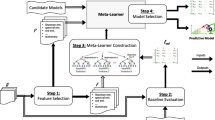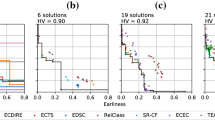Abstract
Estimating the error of classification and regression models is one of the most crucial tasks in machine learning. While the global error is capable to measure the quality of a model, local error estimates are even more interesting: on the one hand they contribute to better understanding of prediction models (where does and where does not work the model well), on the other hand they may provide powerful means to build successful ensembles that select for each region the most appropriate model(s). In this paper we introduce an extremely localized error estimation, called individualized error estimation (IEE), that estimates the error of a prediction model M for each instance x individually. To solve the problem of individualized error estimation, we apply a meta model \({M}^{{_\ast}}\). We systematically investigate various combinations of elementary models M and meta models M ∗ on publicly available real-world data sets. Further, we illustrate the power of IEE in the context of time series classification: on 35 publicly available real-world time series data sets, we show that IEE is capable to enhance state-of-the art time series classification methods.
Access this chapter
Tax calculation will be finalised at checkout
Purchases are for personal use only
Similar content being viewed by others
Notes
- 1.
Hubs are time series that appear most frequently as nearest neighbors of other time series. Denote the set of time series for which t is the nearest neighbor as N t . A hub t is a bad hub if its class label is different from the class labels of many time series in N t . See also (Radovanovic et al. 2010).
References
Ding H, Trajcevski G, Scheuermann P, Wang X, Keogh E (2008) Querying and mining of time series data: Experimental comparison of representations and distance measures. VLDB Endowment 1(2):1542–1552
Domeniconi C, Gunopulos D (2001) Adaptive nearest neighbor classification using support vector machines. Adv NIPS 14:665–672
Domeniconi C, Peng J, Gunopulos D (2002) Locally adaptive metric nearest-neighbor classification. IEEE Trans Pattern Anal Machine Intell 24(9):1281–1285
Duffy N, Helmbold D (2002) Boosting methods for regression. Mach Learn 47:153–200
Frank A, Asuncion A (2010) UCI machine learning repository. Tech. rep., University of California, School of Information and Computer Sciences, Irvine, URL http://archive.ics.uci.edu/ml
Hall M, Frank E, Holmes G, Pfahringer B, Reutemann P, Witten IH (2009) The WEKA data mining software: An update. SIGKDD Explor 11(1):10–18
Hastie T, Tibshirani R (1996) Discriminant adaptive nearest neighbor classification. IEEE Trans Pattern Anal Mach Intell 18(6):607–616
Jain AK, Dubes RC, Chen CC (1987) Bootstrap techniques for error estimation. IEEE Trans Pattern Anal Mach Intell 5(9):606–633
Molinaro AM, Simon R, Pfeiffer RM (2005) Prediction error estimation: a comparison of resampling methods. Bioinformatics 21(15):3301–3307
Radovanovic M, Nanopoulos A, Ivanovic M (2010) Time-series classification in many intrinsic dimensions. In: Proc. 10th SIAM International Conference on Data Mining, SIAM, pp 677–688
Tsuda K, Rätsch G, Mika S, Müller KR (2001) Learning to predict the leave-one-out error of kernel based classifiers. ICANN 2001, LNCS 2130/2001:331–338
Xi X, Keogh E, Shelton C, Wei L, Ratanamahatana CA (2006) Fast time series classification using numerosity reduction. In: Proc. 23th Int’l. Conf. on Machine Learning, ACM, pp 1033–1040
Author information
Authors and Affiliations
Corresponding author
Editor information
Editors and Affiliations
Rights and permissions
Copyright information
© 2012 Springer-Verlag Berlin Heidelberg
About this paper
Cite this paper
Buza, K., Nanopoulos, A., Schmidt-Thieme, L. (2012). Individualized Error Estimation for Classification and Regression Models. In: Gaul, W., Geyer-Schulz, A., Schmidt-Thieme, L., Kunze, J. (eds) Challenges at the Interface of Data Analysis, Computer Science, and Optimization. Studies in Classification, Data Analysis, and Knowledge Organization. Springer, Berlin, Heidelberg. https://doi.org/10.1007/978-3-642-24466-7_19
Download citation
DOI: https://doi.org/10.1007/978-3-642-24466-7_19
Published:
Publisher Name: Springer, Berlin, Heidelberg
Print ISBN: 978-3-642-24465-0
Online ISBN: 978-3-642-24466-7
eBook Packages: Mathematics and StatisticsMathematics and Statistics (R0)




